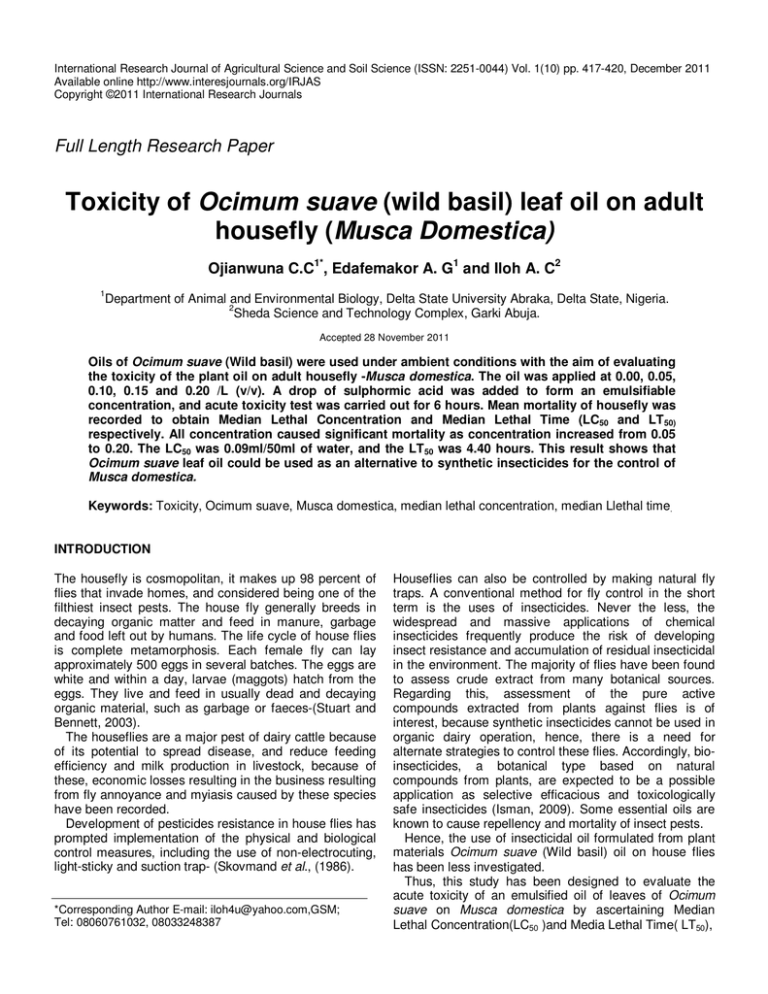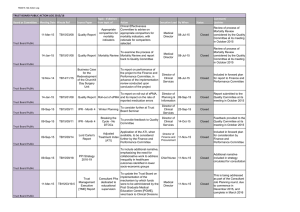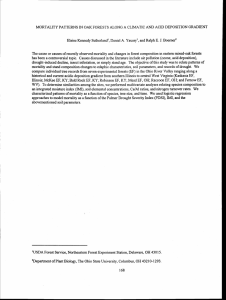Document 14093869
advertisement

International Research Journal of Agricultural Science and Soil Science (ISSN: 2251-0044) Vol. 1(10) pp. 417-420, December 2011 Available online http://www.interesjournals.org/IRJAS Copyright ©2011 International Research Journals Full Length Research Paper Toxicity of Ocimum suave (wild basil) leaf oil on adult housefly (Musca Domestica) Ojianwuna C.C1*, Edafemakor A. G1 and Iloh A. C2 1 Department of Animal and Environmental Biology, Delta State University Abraka, Delta State, Nigeria. 2 Sheda Science and Technology Complex, Garki Abuja. Accepted 28 November 2011 Oils of Ocimum suave (Wild basil) were used under ambient conditions with the aim of evaluating the toxicity of the plant oil on adult housefly -Musca domestica. The oil was applied at 0.00, 0.05, 0.10, 0.15 and 0.20 /L (v/v). A drop of sulphormic acid was added to form an emulsifiable concentration, and acute toxicity test was carried out for 6 hours. Mean mortality of housefly was recorded to obtain Median Lethal Concentration and Median Lethal Time (LC50 and LT 50) respectively. All concentration caused significant mortality as concentration increased from 0.05 to 0.20. The LC50 was 0.09ml/50ml of water, and the LT 50 was 4.40 hours. This result shows that Ocimum suave leaf oil could be used as an alternative to synthetic insecticides for the control of Musca domestica. Keywords: Toxicity, Ocimum suave, Musca domestica, median lethal concentration, median Llethal time. INTRODUCTION The housefly is cosmopolitan, it makes up 98 percent of flies that invade homes, and considered being one of the filthiest insect pests. The house fly generally breeds in decaying organic matter and feed in manure, garbage and food left out by humans. The life cycle of house flies is complete metamorphosis. Each female fly can lay approximately 500 eggs in several batches. The eggs are white and within a day, larvae (maggots) hatch from the eggs. They live and feed in usually dead and decaying organic material, such as garbage or faeces-(Stuart and Bennett, 2003). The houseflies are a major pest of dairy cattle because of its potential to spread disease, and reduce feeding efficiency and milk production in livestock, because of these, economic losses resulting in the business resulting from fly annoyance and myiasis caused by these species have been recorded. Development of pesticides resistance in house flies has prompted implementation of the physical and biological control measures, including the use of non-electrocuting, light-sticky and suction trap- (Skovmand et al., (1986). *Corresponding Author E-mail: iloh4u@yahoo.com,GSM; Tel: 08060761032, 08033248387 Houseflies can also be controlled by making natural fly traps. A conventional method for fly control in the short term is the uses of insecticides. Never the less, the widespread and massive applications of chemical insecticides frequently produce the risk of developing insect resistance and accumulation of residual insecticidal in the environment. The majority of flies have been found to assess crude extract from many botanical sources. Regarding this, assessment of the pure active compounds extracted from plants against flies is of interest, because synthetic insecticides cannot be used in organic dairy operation, hence, there is a need for alternate strategies to control these flies. Accordingly, bioinsecticides, a botanical type based on natural compounds from plants, are expected to be a possible application as selective efficacious and toxicologically safe insecticides (Isman, 2009). Some essential oils are known to cause repellency and mortality of insect pests. Hence, the use of insecticidal oil formulated from plant materials Ocimum suave (Wild basil) oil on house flies has been less investigated. Thus, this study has been designed to evaluate the acute toxicity of an emulsified oil of leaves of Ocimum suave on Musca domestica by ascertaining Median Lethal Concentration(LC50 )and Media Lethal Time( LT50), 418 Int. Res. J. Agric. Sci. Soil Sci. Table 1. Percentage mortality and probit mortality of adult housefly (Musca domiestica) exposed for 1-6 hour to the toxic effects of Ocimum suave (Wild basil) oil. Conc (ml)/50mls of H2O 0.00 0.05 0.10 0.15 0.20 Logarithm concentration. Hours 1 2 0.0000 -1.3000 -1.0000 -0.8000 -0.6000 X 0.00 1.0 1.5 1.5 1.0 a 1.0 0.00 2.0 2.5 3.5 4.0 ab 2.4 3 0.00 3.5 5.5 5.5 8.5 abc 4.6 to determine the effect of Ocimum suave extract in the adult housefly and also to access the effectiveness of the plant extract for housefly control. MATERIALS AND METHODS Preparation of Insecticidal Plant Materials The plant materials that were used in this study were obtained from Issele-Azagba (Aniocha North Local Government Area of Delta State), and identified as Ocimum suave by Ilondu E.M in Department of Botany, Delta State University, Abraka. The plant materials were dried at room temperature (270C) for two weeks. The dried plant materials were grounded using a high speed grinder. The powder was filtered through a sieve of 0.1mm mesh size and then put in an airtight container to prevent active components from evaporation (Ojianwuna and Umoru, 2010). The leaf powder was dissolved in ether and its oil was extracted using a Soxhlet extractor. The ether was recovered using a rotary evaporator. The oil was then preserved in an airtight container to prevent the active ingredients from escaping and was covered and kept in a cupboard until it was used for the experiment. 4 5 6 0.00 3.5 6.0 6.0 10.0 abc 5.1 0.00 4.0 7.0 10.5 10.5 bc 6.4 0.00 5.0 8.0 12.5 15.0 c 8.1 % Mortality Probit Mortality Mean X 0.00 33.3 53.3 83.3 100 0.00 4.56 5.08 5.97 8.71 0.00a 3.2ab bc 5.1 bc 6.6 c 8.2 Formulation of Insecticidal Plant Materials (Wild basil) Cages were labeled according to the concentration of the formulation. Plant oil were taken in quantities 0.00, 0.05, 0.10, 0.15 and 0.20 with a micro pipette, and added to 50ml of distilled water in a spraying bottle, few drops of sulphumic acid were then added to this mixture to form an emulsifiable concentration. The spraying bottles were shaken thoroughly to ensure proper mixture. A controlspraying bottle labeled as 0.00 was set up by adding 50 ml of distilled water, without wild basil oil. Experimental Setup 15 freshly emerged adult’s houseflies were introduced into each of the ten cages. The spraying bottles and the cages were being labeled according to the various concentrations; i.e. 0.05, 0.10, 0.15, 0.20 and 0.00 (control). The insect (houseflies) were sprayed, and the acute mortality test was carried out for six (6) hours to determine the LC50 and LT50. Two replicates were conducted in this experiment and the mean mortality was taken. Statistical Analysis at p<0.01 Insect Culture The insect cages were built in the size of 15cm x 15cm x 15cm. The cages were built with net and wire gauze. Adult houseflies used for the experiment were obtained by placing stool on Petri dishes to attract flies into the cages. The insects were then cultured. Feacal samples were placed in the Petri dishes and kept in the cage for the housefly to feed on. The flies were allowed to lay eggs and mature to adult. The newly emerged adults were used for the experiment. As the adult emerged, 15 adults irrespective of their sexes were transferred into each cage and fed with fresh stool samples. The data calculated were analyzed using Analysis of Variation (ANOVA), Probit analysis (Finney, 1971) and Multiple comparison using Turkey’S multiple comparison test. RESULTS Table 1 shows the percentage mortality of adult houseflies (Musca domestica) when exposed to various concentration of Ocimum suave) oil for (1-6 hours). The result shows that there were significant differences Ojianwuna et al. 419 Probit Log concentration Figure 1. The relationship between probit mortality and logarithm concentration to give ml concentration at (antilog)LC50. (P<0.01) in the mean mortality of the housefly as the concentrationof plant oil increased from 0.05ml to 0.20ml/50ml of water. The lethal concentration (LC50) was found to be 0.04/50ml as shown in Figure 1. However, it was observed also that as the time increased from the 1st hour to the 6th hour of spraying, the mortality was significant (P<0.01), and the lethal time (LT50) was 4.40 hrs as shown in Figure 2. DISCUSSION AND CONCLUSION The work is to evaluate the toxicity of Ocimum suave leaf oil on adult housefly by ascertaining the LC50 and LT50. The plant material was toxic to the adult housefly as the concentration increased from 0.05 to 0.20ml/50ml of water. The toxicity of the plant extract could be as a result of the volatile compounds in the plant extract which caused the mortality and produced insecticidal effects on adult housefly (Musca domestica). Ilondu et al., (2004) observed that Ocimum suave (Wild basil) caused mortality of adult Rhizopertha dominica in grain cereals at the 2-8g plant materials per 50g cereals (rice, maize and sorghum). This protects the cereals after 90 days post treatment. Assastyasih and Madden (1986) reported the successful use of oil clove, black pepper and ginger dissolved in alcohol caused mortality on adult housefly (Musca domestica). Esther et al., (1995) observed that oil extracted from the leaves of tropical shrub Ocimum suave cause mortality in all stages of the tick Rhipicephalus appendiculatus. A 10% solution was found to kill all immature and more than 70% of adults feeding on LT50 =4.40Hours Figure 2. The relationship between probit mortality and logarithm concentration to give ml concentration at (antilog)LT50 rabbits. The main constituents of Ocimum suave include eugenol, mono and sesquiterpenoids (Hassanli et al., 1990). The toxicity of the result in this study may have been due to the toxic effects of the compounds found in the plant extract. In addition, as an emulsifiable concentrate, the leaf oil formulation greatly reduced size particles and was evenly mixed within the water column. The spread of these fine particles probably increased the efficiency of the formulation. It is observed that mortality generally was significantly different (P<0.01) as the concentration of the plant extract increased from 0.05 to 0.20ml/50ml of water. The LC50 was 0.04./50ml of water; this was compared with the result reported by Hidayatulfathi et al. (2003) when working with Malaysian plant (Acorus calamus) extracts against adult Aedes aegypti L. The hexane fraction from methanol extract of Acorus calamus rhizome was effective, exhibiting LC50 -2 -2 and LC90 values of 0.04 mg/cm and 0.09 mg/cm respectively. The LC50 of 0.04conc /50ml was also compared with conventional acaricides, such as chlorofenvinphos (Supona; LC50 0.021%, Coumaphos (Asuntol); LC50 0.039% and Oxinothiophos (Bacdip); LC50 0.072% on a susceptible strain of Bophilus microplus (FAO, 1984). A comparison of the LC50 results presented in the study with the outcome from various other studies on efficacy of different products are different notably because of the origin of products, concentration of active ingredients of products, more of plant extract and parts of plant which the oil was extracted. However, there was a significant difference (P<0.01) in mortality amongst the exposure period of 4.40 hrs. Ogendo et al. (2003) observed toxicity effects of Lantana 420 Int. Res. J. Agric. Sci. Soil Sci. camara and Tephrosia vogelii and a synthetic pesticide against Sitophilus zeamais. Maize treated with Actellic super 2% dust achieved a 100% killing within two days. The two-plant extract induced insect mortality over amuch longer exposure period. Both plant materials registered less than 50% mortality during the first five days and 82-95% mortality at 21 days. The LT50 varied from five to six days for higher dosages (7.5 and 10% w/w) to seven to eight days for the lower dosages (2.5 and 5% w/w). Echezona (2006) reported that within six days after treatment, Nsukka yellow pepper, Tatashi pepper and Sombo pepper caused about 88%, 82% and 78% adult bruchid mortality respectively, during the same period. Similar finding on mortality of housefly (Musca domestica) were also obtained by Khan and Ahmed (2000) using extract of plant materials which include crude Azadirachta indica extract leaf against adult housefly and there was mortality. Sukontason et al, (2004) reported toxicity of Eucalyptol extract against Musca domestica and mortality was recorded. Singh and Singh (1991) screened 31 essential oils from different botanical sources against Musca domestica and reported insecticidal activities against the species, and there was also mortality. Nuralain et al (1994) reported that extract of crude neem seed kernel caused mortality of adult Musca domestica. Scientific findings have in the past established the efficacy of some indigenous plants products as effective control of insect pest. They offer a safer alternative to synthetic chemicals and can be obtained by individuals or communities easily at a low cost. Although most of the plants are not as effective as synthetic insecticides and do not produce fast results, their use for the control of a large scale program under epidemic condition may not yield the desired results but can provide a prophylactic measure for protection against insect pest attack. It is necessary to identify the active ingredients of the plant responsible for the insecticide value. This is however, difficult and highly technical exercise requiring cooperation between entomologists and chemists. However, the success of such an undertaking depends to a large extent on the ability of scientist to carry out the researches at a relatively low cost so that the end product would be cheaper and affordable than current used insecticides. REFERENCES Assastyasih M, Madden J (1986). Effect of Plant Products and Extracts on the Acceptability of fish to Houseflies. Research Institute Fishery Technology. Jakarta, Indonesia, pp:12. Echezona BC (2006). Selection of Pepper Cultivars (Capsicum spp) for the Control of Bruchid, Callosobruchus maculatus (F) on Stored Cowpea (Vigna unguiculata (L) (Walp) Seeds. Afri. J. Biotechnol. 5(8):624-628. Esther NM, Ahmed H, Suliman E, Edward ML, Mark K (1995). Repellent and Acaricidal Properties of Ocimum suave against Rhipicephalus appendiculatus tick. Experimental and Applied Acarology. 19(1995):11-18. FAO. (1984). Report Acaricide Resistance in Ticks and Tick-Borne Disease Control. A Practical Field Manual. 1:246-299. Hassanli A, Iwande W, Ole-Sitayo N Moreka L, Nokoe S (1990). Weevil Repellent Constituents of Ocimum suave Leaves and Eugenia caryophyllata cloves used as grain protectant in parts of Eastern Africa. Discovery and Innovation. 2:91-95. Hidayatulfathi O, Sallehudin S, Ibrahim J, Azizol AK (2003). Adulticidal Activity of Some Malaysian Plant (Acorus Calamus) Extracts Against Aedes aegypti Linnaeus. Tropical biomedicine. 20:153-157. Ilondu EM, Egwunyenga OA, Iloh AC (2004). The Effects of Wild Basil (Ocimum suave) Wild labiatee: (lamiacae) Leaf Dust as Protectant of Cereals, Against Rhizopertha dominica (f) Coleoptera: (bostrydae). J. National Academic. Adv. Sci. 3:129-134. Isman MB (2009). Plant Essential Oils for Pest and Disease Management. Crop protect. 19, 603-608. Khan MF, Ahmad SM (2000). Toxity of Crude Neem Extract Against House Fly Musca domestica Adults as Compared DDVP (Dichlorvos). Turk J. Zool. 24:219-223. Nurulain SM, Tabassum R, Naqvi SNH (1994). Synergistic Formulation of a Neem Product and its IGR Effects on Musca domestica. (PCSIR Strian). Pakistan J. Entomol.Kar. 9:43-50. Ogendo JO, Belmain SR, Deng AL (2003). Comparision of Toxic Effects of Lantana Camara L. with Tephrosia Vogelii Hook and a Synthetic Pesticide against Sitophilus zeamais. Insect Sci. Applic. 23(2):127135. Ojianwuna CC, Umoru PA (2010). Effects of Cymbopogon citrus (Lemon Grass) and Ocimum suave (Wild Basil) Applied as Mixed and Individual Powders on the Eggs Laid and Emergence of Adult Callosobruchus maculates (Cowpea bruchids). African Journal of Agricultural Research, 5(20):2837-2840. Singh DS, Singh AK (1991). Repellent and insecticidal properties of essential oils against house fly, (Musca domestica). Journal of Insect Science APPL. 12:487-491. Skovmand O,Mouvier H.(1986). Electrocuting light traps evacuated for control of houseflies. J. Appl. Entomol.102:446-455. Stuart B (2003). “Housefly” http:11 www.thepiedpiper.co.uk-/th6a.htm. Sukontason KL, Boorchu N, Sukontason K, Choochote W (2004). Effects of eucalyptol on housefly (Diptera: muscidae). Revista de institute de medecina tropical de Sao Paulo. 46, 97-101.




